Assessing Impacts of Wood Utilisation Scenarios for a Lithuanian Bioeconomy: Impacts on Carbon in Forests and Harvested Wood Products and on the Socio-Economic Performance of the Forest-Based Sector
Abstract
:1. Introduction
2. Method
2.1. Wood Value Chains
2.2. Simulation and Assessment Tools
2.3. Wood Use Scenarios
3. Results
3.1. Socio-Economic Impacts
3.2. Environmental Impacts
3.3. Comparing Impacts of Different Scenarios
4. Discussion
4.1. Scenario Trade-Offs
4.2. Effect of System Boundaries
4.3. Scenario Assumptions
4.4. Data and Tools
4.5. Comparison to Previous Studies
4.6. Policy Implications
5. Conclusions
Supplementary Materials
Acknowledgments
Author Contributions
| Conception and design | GJ, ML |
| Planning | GJ, ML |
| Data collection | GJ, PJV |
| Data analysis | GJ, PJV |
| Writing the article | GJ, ML, PJV, MA |
| Editing and reviewing the article | GJ, ML |
| Overall responsibility | GJ |
| GJ = Gediminas Jasinevičius, ML = Marcus Lindner, PJV = Pieter Johannes Verkerk and MA = Marius Aleinikovas | |
Conflicts of Interest
References
- European Commission. Communication from the Commission to the European Parliament, the Council, the European Economic and Social Committee and the Committee of the Regions. Innovating for Sustainable Growth. A Bioeconomy for Europe. Brussels, Belgium, 2012. Available online: Http://ec.europa.eu/research/bioeconomy/pdf/official-strategy_en.pdf (accessed on 3 January 2017).
- Teischinger, A. The Forest-based sector value chain—A tentative survey. Lenzing. Ber. 2009, 87, 1–10. [Google Scholar]
- Näyhä, A.; Hetemäki, L.; Stern, T. New Products Outlook. In Future of the European Forest-Based Sector: Structural Changes towards Bioeconomy; What Science Can Tell Us 6; Hetemäki, L., Ed.; European Forest Institute: Joensuu, Finland, 2014; p. 43. Available online: Http://www.efi.int/files/attachments/publications/efi_wsctu_6_2014.pdf (accessed on 3 January 2017).
- Näyhä, A.; Pelli, P.; Hetemäki, L. Services in the forest-based sector—Unexplored futures. Foresight 2015, 17, 378–398. [Google Scholar] [CrossRef]
- Scarlat, N.; Dallemand, J.F.; Monforti-Ferrario, F.; Nita, V. The role of biomass and bioenergy in a future bioeconomy: Policies and facts. Environ. Dev. 2015, 15, 3–34. [Google Scholar] [CrossRef]
- Gustavsson, L.; Pingoud, K.; Sathre, R. Carbon dioxide balance of wood substitution: Comparing concrete and wood—Framed buildings. Mitig. Adapt. Strateg. Glob. Chang. 2006, 11, 667–691. [Google Scholar] [CrossRef]
- Sathre, R.; Gustavsson, L. Using wood products to mitigate climate change: External costs and structural change. Appl. Energy 2009, 86, 251–257. [Google Scholar] [CrossRef]
- Eriksson, E.; Gillespie, A.R.; Gustavsson, L.; Langvall, O.; Olsson, M.; Sathre, R.; Stendahlg, J. Integrated carbon analysis of forest management practices and wood substitution. Can. J. For. Res. 2007, 37, 671–681. [Google Scholar] [CrossRef]
- Nabuurs, G.J.; Delacote, P.; Ellison, D.; Hanewinke, M.; Lindner, M.; Nesbit, M.; Ollikainen, M.; Savaresi, A. A New Role for Forests and the Forest Sector in the EU Post-2020 Climate Targets; From Science to Policy 2; Hetemäki, L., Ed.; European Forest Institute: Joensuu, Finland, 2015; Available online: Http://www.efi.int/files/attachments/publications/efi_fstp_2_2015.pdf (accessed on 3 January 2017).
- Hurmekoski, E.; Hetemäki, L. Studying the future of the forest sector: Review and implications for long-term outlook studies. For. Policy Econ. 2013, 34, 17–29. [Google Scholar] [CrossRef]
- Hurmekoski, E.; Hetemäki, L.; Linden, M. Factors affecting sawnwood consumption in Europe. For. Policy Econ. 2015, 50, 236–248. [Google Scholar] [CrossRef]
- Bemmann, A.; Grosse, W. Changes of forest ownership in the countries of transition in Middle and East Europe. Allg. For. Jagdztg. 2001, 172, 173–183. [Google Scholar]
- Ioras, F.; Abrudan, I.V. The Romanian forestry sector: Privatisation facts. Int. For. Rev. 2006, 8, 361–367. [Google Scholar] [CrossRef]
- Munteanu, C.; Nita, M.D.; Abrudan, I.V.; Radeloff, V.C. Historical forest management in Romania is imposing strong legacies on contemporary forests and their management. For. Ecol. Manag. 2016, 361, 179–193. [Google Scholar] [CrossRef]
- Toppinen, A.; Viitanen, J.; Leskinen, P.; Toivonen, R. Dynamics of Roundwood Prices in Estonia, Finland and Lithuania. Balt. For. 2005, 11, 88–96. [Google Scholar]
- Muiste, P.; Kurvits, V.; Mitt, R.; Teder, M.; Kakko, T. Forest harvesting in Estonia during the transition period. For. Stud. 2006, 45, 164–171. [Google Scholar]
- Rendenieks, Z.; Nikodemus, O.; Brūmelis, G. Dynamics in forest patterns during times of forest policy changes in Latvia. Eur. J. For. Res. 2015, 134, 819–832. [Google Scholar] [CrossRef]
- Lithuanian Statistical Yearbook of Forestry. State Forest Sevice, Kaunas, Lithuania, 2015. Available online: http://www.amvmt.lt/index.php/leidiniai/misku-ukio-statistika/2015 (accessed on 3 January 2017).
- Morkevičius, A. Wood Industry in Lithuania: From the Begining Until 2000; Association “Lithuanian Wood”: Vilnius, Lithuania, 2001. [Google Scholar]
- Brukas, A.; Kairiūkštis, L. The Chronicle of Lithuanian Forests; Juodvalkis, A., Kairiūkštis, L., Ozolinčius, R., Eds.; UAB “Perto Ofsetas”: Vilnius, Lithuania, 2003; p. 181. [Google Scholar]
- Kuliešis, A.; Kasperavičius, A.; Kulbokas, G. Analysis on Forest Growth and Forest Management 2014. Available online: http://mef.asu.lt/wp-content/uploads/sites/5/2014/12/17_medienos_priea20141121.pdf (accessed on 3 January 2017).
- Kupstaitis, N.; Head of Division on Forest Sector Development, Ministry of Environment of the Republic of Lithuania, Vilnius, Lithuania. Personal communication, 2016.
- National Forestry Sector Development Programme for 2012–2020; Approved by Resolution No. 569; Government of the Republic of Lithuania: Vilnius, Lithuania, 2012.
- Lippke, B.; Oneil, E.; Harrison, R.; Skog, K.; Gustavsson, L.; Sathre, R. Life cycle impacts of forest management and wood utilization on carbon mitigation: Knowns and unknowns. Carbon Manag. 2011, 2, 303–333. [Google Scholar] [CrossRef]
- Hiraishi, T.; Krug, T.; Tanabe, K.; Srivastava, N.; Baasansuren, J.; Fukuda, M.; Troxler, T.G. (Eds.) 2013 Revised Supplementary Methods and Good Practice Guidance Arising from the Kyoto Protocol; Intergovernmental Panel on Climate Change: Switzerland, 2014; p. 148. Available online: Http://www.ipcc-nggip.iges.or.jp/public/kpsg/pdf/KP_Supplement_Entire_Report.pdf (accessed on 3 January 2017).
- Sallnäs, O. A matrix model of the swedish forest. Stud. For. Suec. 1990, 1–23. [Google Scholar]
- Verkerk, P.J.; Schelhaas, M.J.; Immonen, V.; Hengeveld, G.; Kiljunen, J.; Lindner, M.; Nabuurs, G.J.; Suominen, T.; Zudin, S. Manual for the European Forest Information Scenario model (EFISCEN 4.1). EFI Technical Report 99. European Forest Institute: Finland, Joensuu, 2016; p. 49. Available online: Http://www.efi.int/files/attachments/publications/efi_tr_99_2016_verkerk_et_al.pdf (accessed on 3 April 2017).
- Karjalainen, T.; Pussinen, A.; Liski, J.; Nabuurs, G.J.; Eggers, T.; Lapveteläinen, T.; Kaipainen, T. Scenario analysis of the impacts of forest management and climate change on the European forest sector carbon budget. For. Policy Econ. 2003, 5, 141–155. [Google Scholar] [CrossRef]
- Eggers, J.; Lindner, M.; Zudin, S.; Zaehle, S.; Liski, J. Impact of changing wood demand, climate and land use on European forest resources and carbon stocks during the 21st century. Glob. Chang. Biol. 2008, 14, 2288–2303. [Google Scholar] [CrossRef]
- Böttcher, H.; Verkerk, P.J.; Gusti, M.; Havlik, P.; Grassi, P. Projection of the future EU forest CO2 sink as affected by recent bioenergy policies using two advanced forest management models. GCB Bioenergy 2012, 4, 773–783. [Google Scholar] [CrossRef]
- Lindner, M.; Suominen, T.; Palosuo, T.; Garcia-Gonzaloa, J.; Verweij, P.; Zudin, S.; Päivinen, R. ToSIA—A tool for sustainability impact assessment of forest-wood-chains. Ecol. Model. 2010, 221, 2197–2205. [Google Scholar] [CrossRef]
- Päivinen, R.; Lindner, M.; Rosén, K.; Lexer, M.J. A concept for assessing sustainability impacts of forestry-wood chains. Eur. J. For. Res. 2010, 131, 7–19. [Google Scholar] [CrossRef]
- Tsupari, E.; Tormonen, K.; Monni, S.; Vahlman, T.; Kolsi, A.; Linna, V. Emission Factors for Nitrous Oxide and Methane. Technical Research Centre of Finland: Espoo, Finland, 2006. Available online: Http://www.vtt.fi/inf/pdf/workingpapers/2006/W43.pdf (accessed on 3 January 2017).
- Sathre, R.; O’Connor, J. A Synthesis of Research on Wood Products and Greenhouse Gas Impacts, 2nd ed.; Technical Report TR-19R; FPInnovations: Vancouver, BC, Canada, 2010; p. 117. [Google Scholar]
- Wilson, J.B. Life-cycle inventory of particleboard in terms of resources, emissions, energy and carbon. Wood Fiber Sci. 2010, 42, 90–106. [Google Scholar]
- Wolfslehner, B.; Huber, P.; Lexer, M.J. Smart Use of Small-diameter Hardwood—A Forestry-wood Chain Sustainability Impact Assessment in Austria. Scand. J. For. Res. 2013, 28, 184–192. [Google Scholar] [CrossRef]
- Brunet-Navarro, P.; Jochheim, H.; Muys, B. Modelling carbon stocks and fluxes in the wood product sector: A comparative review. Glob. Chang. Biol. 2016, 22, 2555–2569. [Google Scholar] [CrossRef] [PubMed]
- Jasinevičius, G.; Lindner, M.; Cienciala, E.; Tykkyläinen, M. Carbon accounting in harvested wood products: Assessment using material flow analysis resulting in larger pools compared to the IPCC default method. J. Ind. Ecol. 2017. [Google Scholar] [CrossRef]
- Mantau, U. Wood flow analysis: Quantification of resource potentials, cascades and carbon effects. Biomass Bioenergy 2015, 79, 28–38. [Google Scholar] [CrossRef]
- Pilli, R.; Fiorese, G.; Grassi, G. EU mitigation potential of harvested wood products. Carbon Balance Manag. 2015, 10. [Google Scholar] [CrossRef] [PubMed]
- Kuliešis, A.; Pertrauskas, E. Lithuanian Forest Resources in the XXI Century; Bružinskas, P., Grigaliūnas, J., Šatkus, J., Eds.; Forest Inventory and Management Institute: Kaunas, Lithuania, 2000. [Google Scholar]
- Consolidated Version of the Treaty on the Functioning of the European Union. Official Journal of the European Union. 2012. Available online: http://eur-lex.europa.eu/legal-content/EN/TXT/PDF/?uri=CELEX:12012E/TXT&from=EN (accessed on 3 January 2016).
- Jasinevičius, G.; Lindner, M.; Tykkyläinen, M.; Pingoud, K. Review of Models for Carbon Accounting in Harvested Wood Products. Int. Wood Prod. J. 2015, 6, 198–212. [Google Scholar] [CrossRef]
- Pilli, R.; Grassi, G.; Kurz, W.A.; Viñas, R.A.; Guerrero, N.H. Modelling forest carbon stock changes as affected by harvest and natural disturbances. Comparison with countries’ estimates for forest management. Carbon Balance Manag. 2016, 11, 1–18. [Google Scholar] [CrossRef] [PubMed]
- Knauf, M. An analysis of wood market balance modeling in Germany. For. Policy Econ. 2015, 50, 319–326. [Google Scholar] [CrossRef]
- Jochem, D.; Weimar, H.; Bösch, M.; Mantau, U.; Dieter, M. Estimation of wood removals and fellings in Germany: A calculation approach based on the amount of used roundwood. Eur. J. For. Res. 2015, 134, 869–888. [Google Scholar] [CrossRef]
- Parobek, J.; Paluš, H.; Kaputa, V.; Šupín, M. Analysis of Wood Flows in Slovakia. BioResources 2014, 9, 6453–6462. [Google Scholar] [CrossRef]
- Eriksson, L.O.; Gustavsson, L.; Hänninen, R.; Kallio, M.; Lyhykäinen, H.; Pingoud, K.; Valsta, L. Climate Change Mitigation Through Increased Wood Use in the European Construction Sector—Towards an Integrated Modelling Framework. Eur. J. For. Res. 2012, 131, 131–144. [Google Scholar] [CrossRef]
- Poudel, B.C.; Sathre, R.; Gustavsson, L.; Bergh, J.; Lundström, A.; Hyvönen, R. Effects of climate change on biomass production and substitution in North-central Sweden. Biomass Bioenergy 2011, 35, 4340–4355. [Google Scholar] [CrossRef]
- Lundmark, T.; Bergh, J.; Hofer, P.; Lundström, A.; Nordin, A.; Poudel, B.C.; Sathre, R.; Taverna, R.; Werner, F. Potential Roles of Swedish Forestry in the Context of Climate Change Mitigation. Forests 2014, 5, 557–578. [Google Scholar] [CrossRef]
- Gillenwater, M. What Is Additionality? Part 1: A Long Standing Problem. Discussion Paper No. 001, Version 03. Greenhouse Gas Management Institute: Washington, DC, USA, 2012. Available online: Http://ghginstitute.org/wp-content/uploads/2015/04/AdditionalityPaper_Part-1ver3FINAL.pdf (accessed on 3 April 2017).
- Knauf, M. The wood market balance as a tool for calculating wood use’s climate change mitigation effect—An example for Germany. For. Policy Econ. 2016, 66, 18–21. [Google Scholar] [CrossRef]
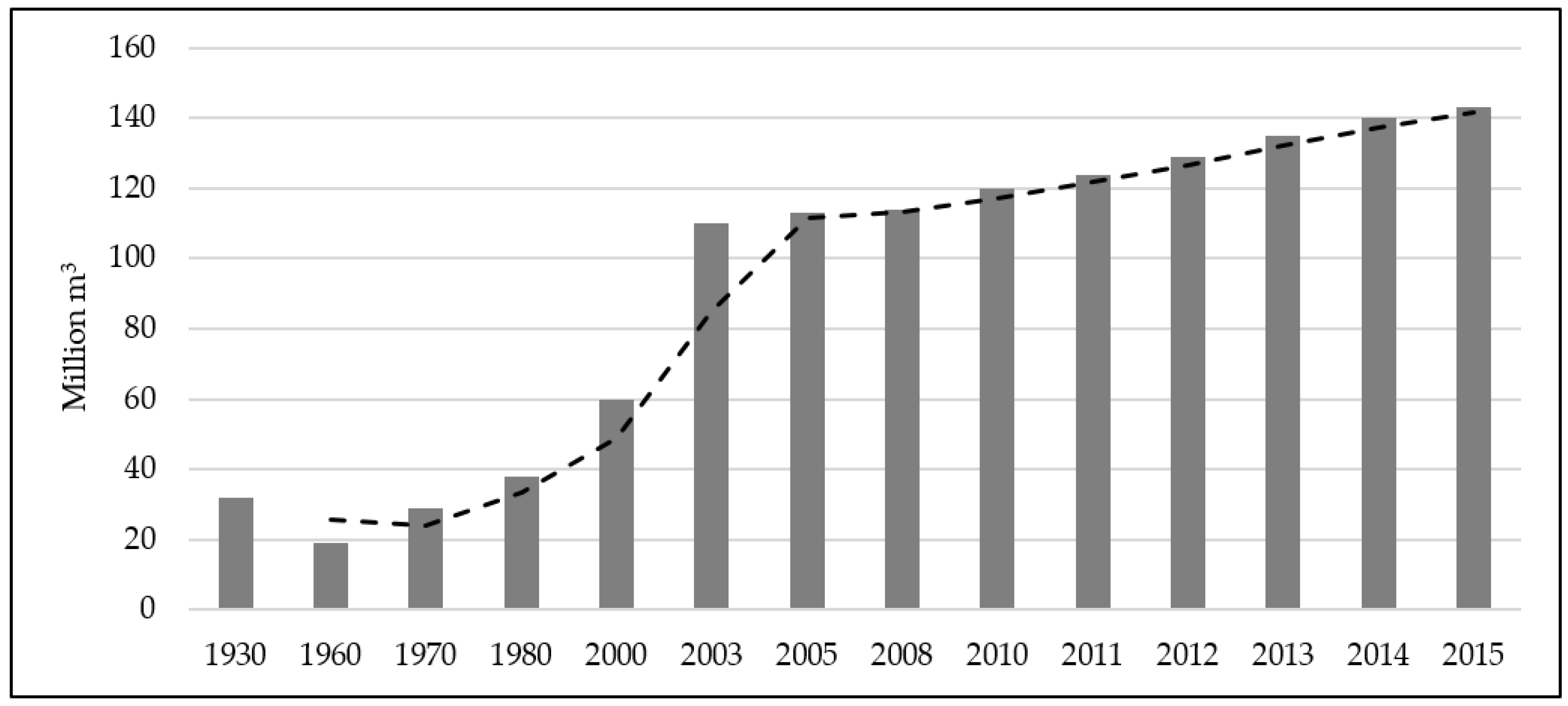
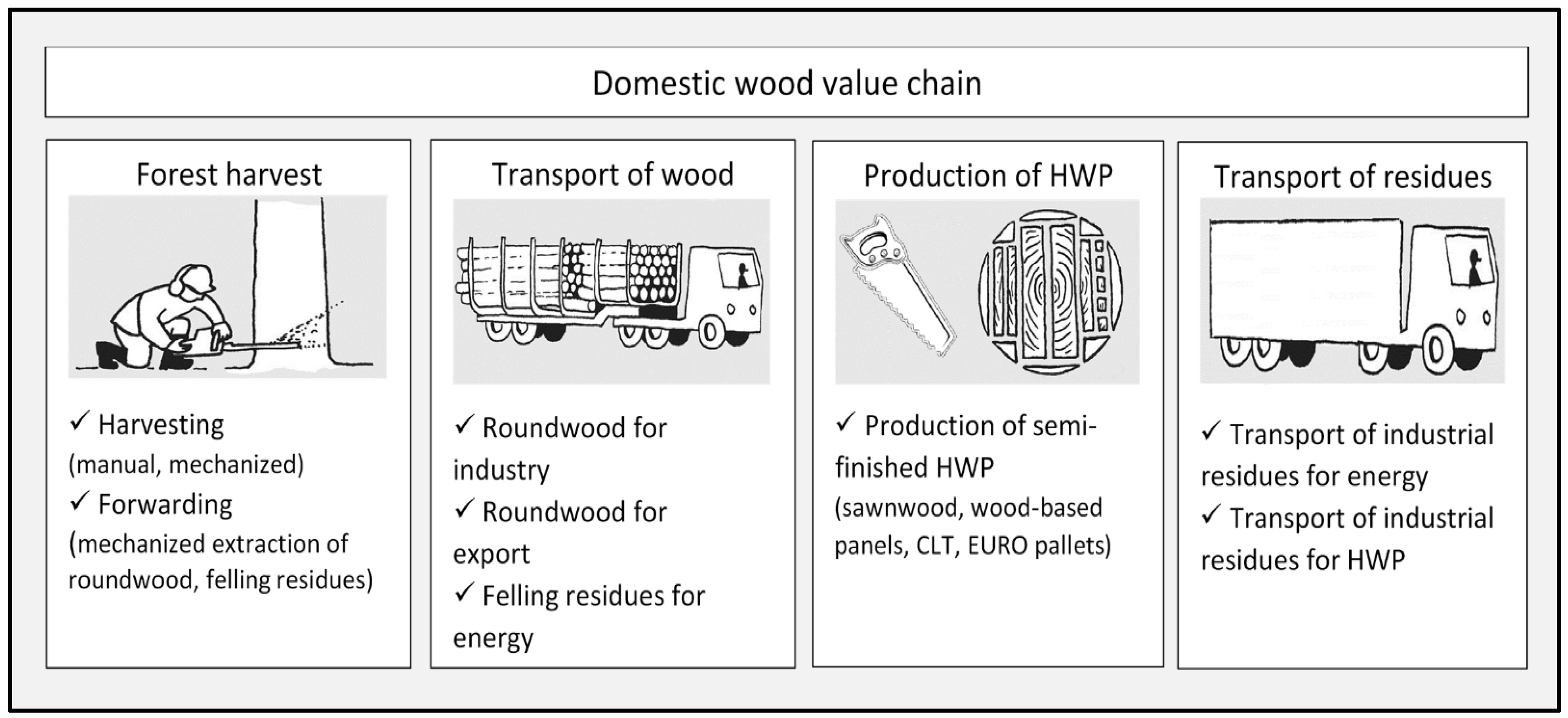
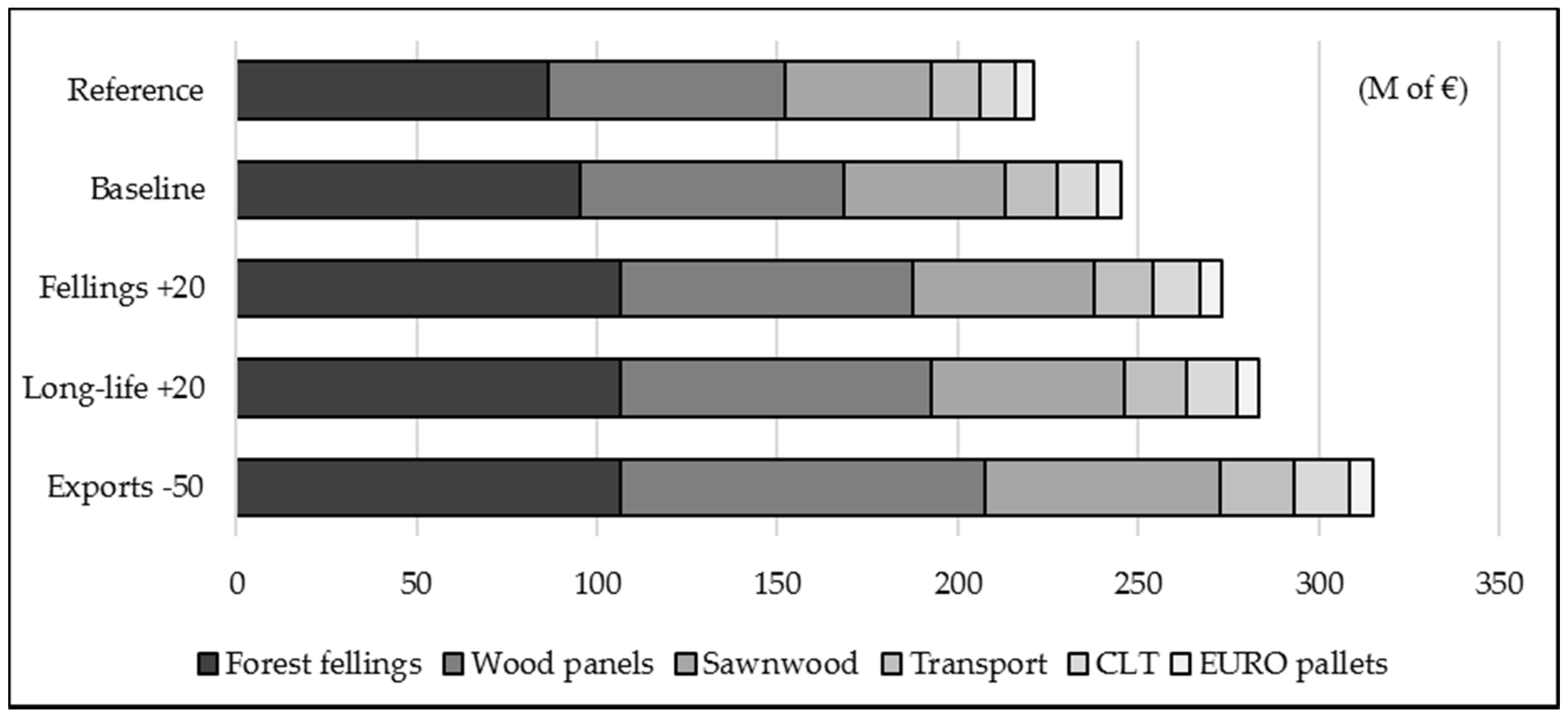
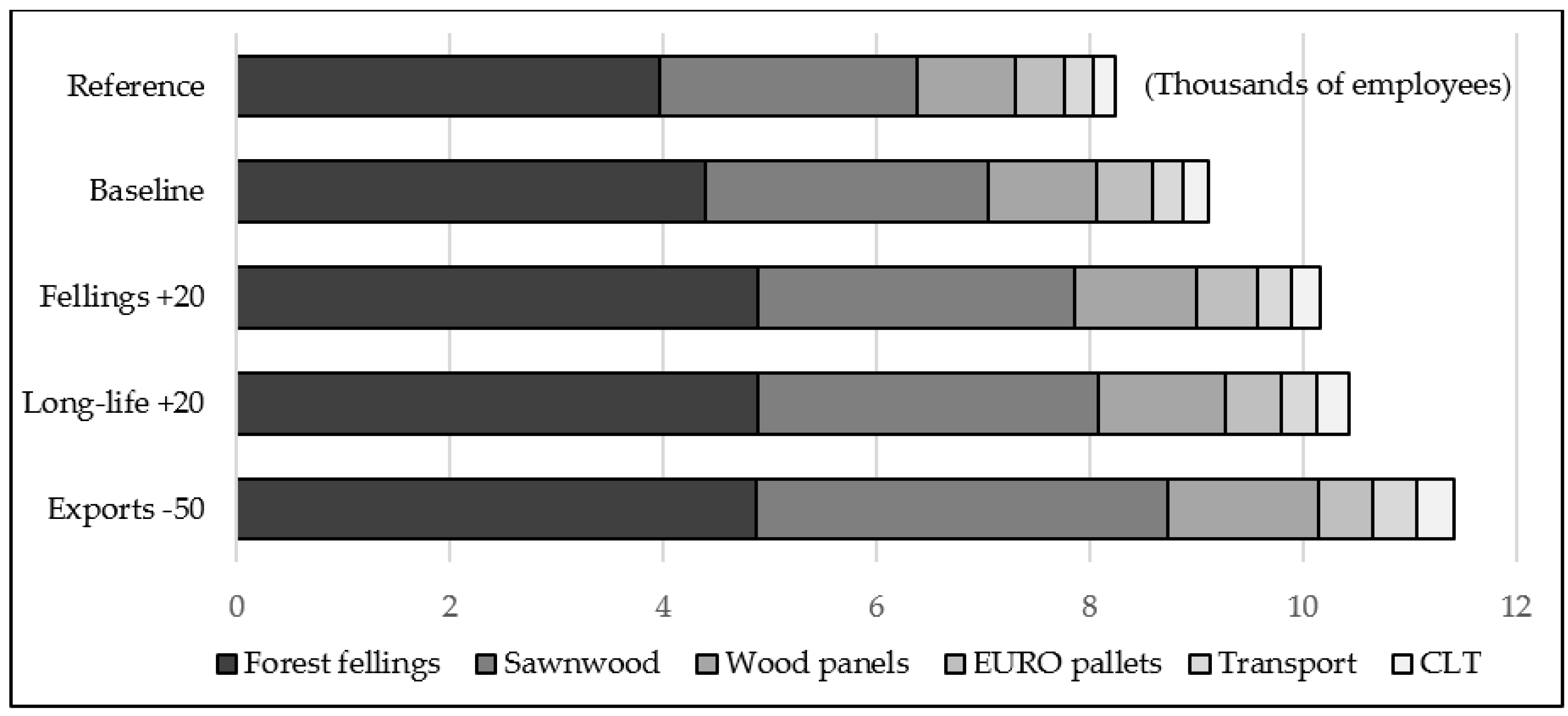
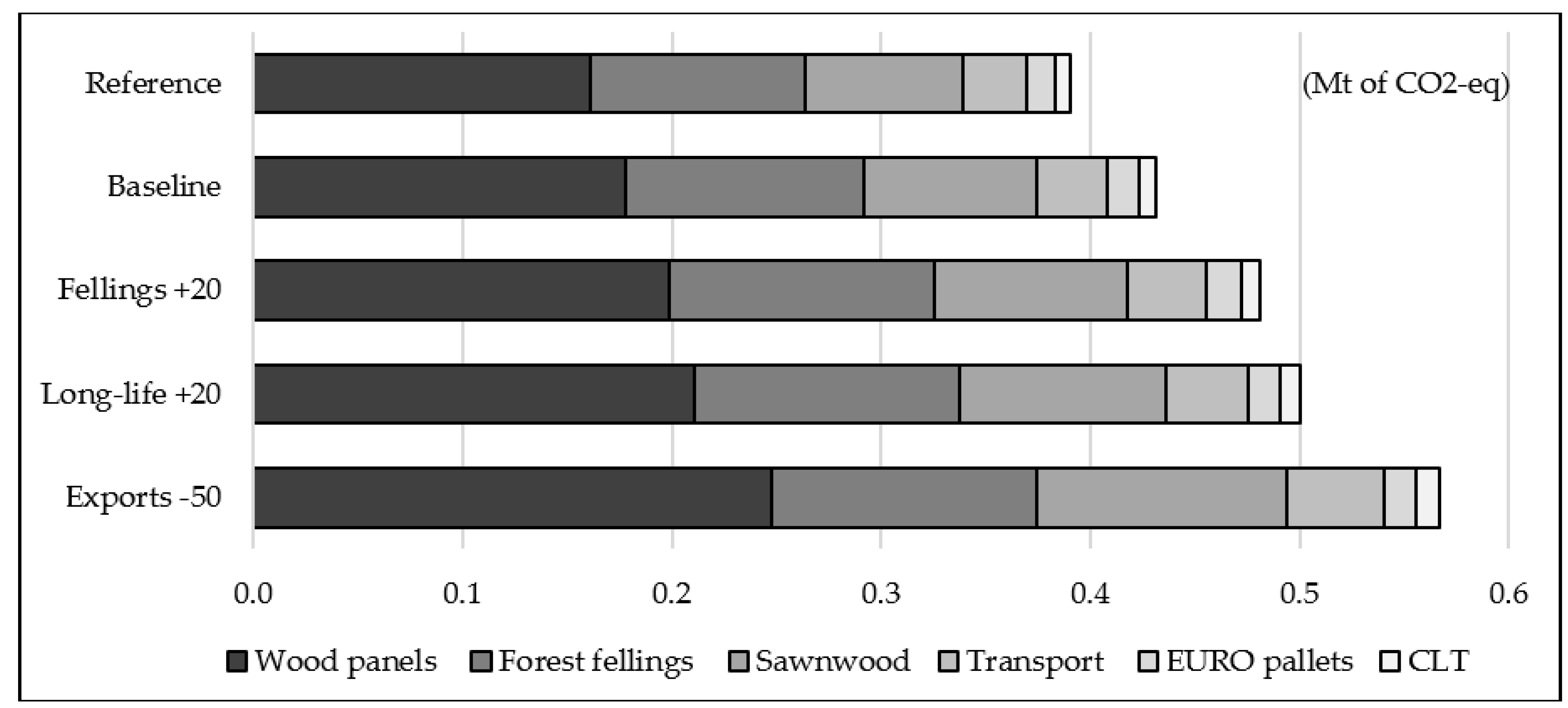
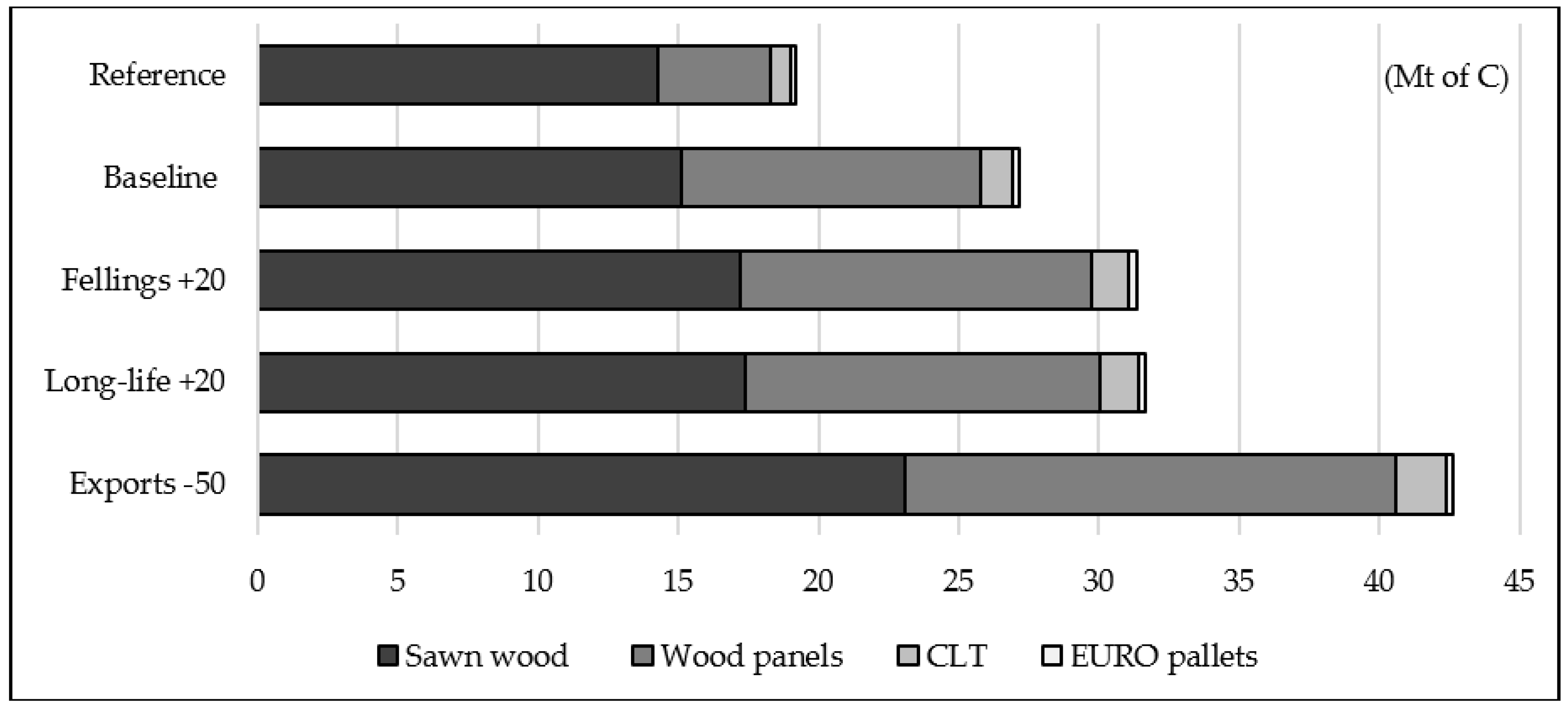
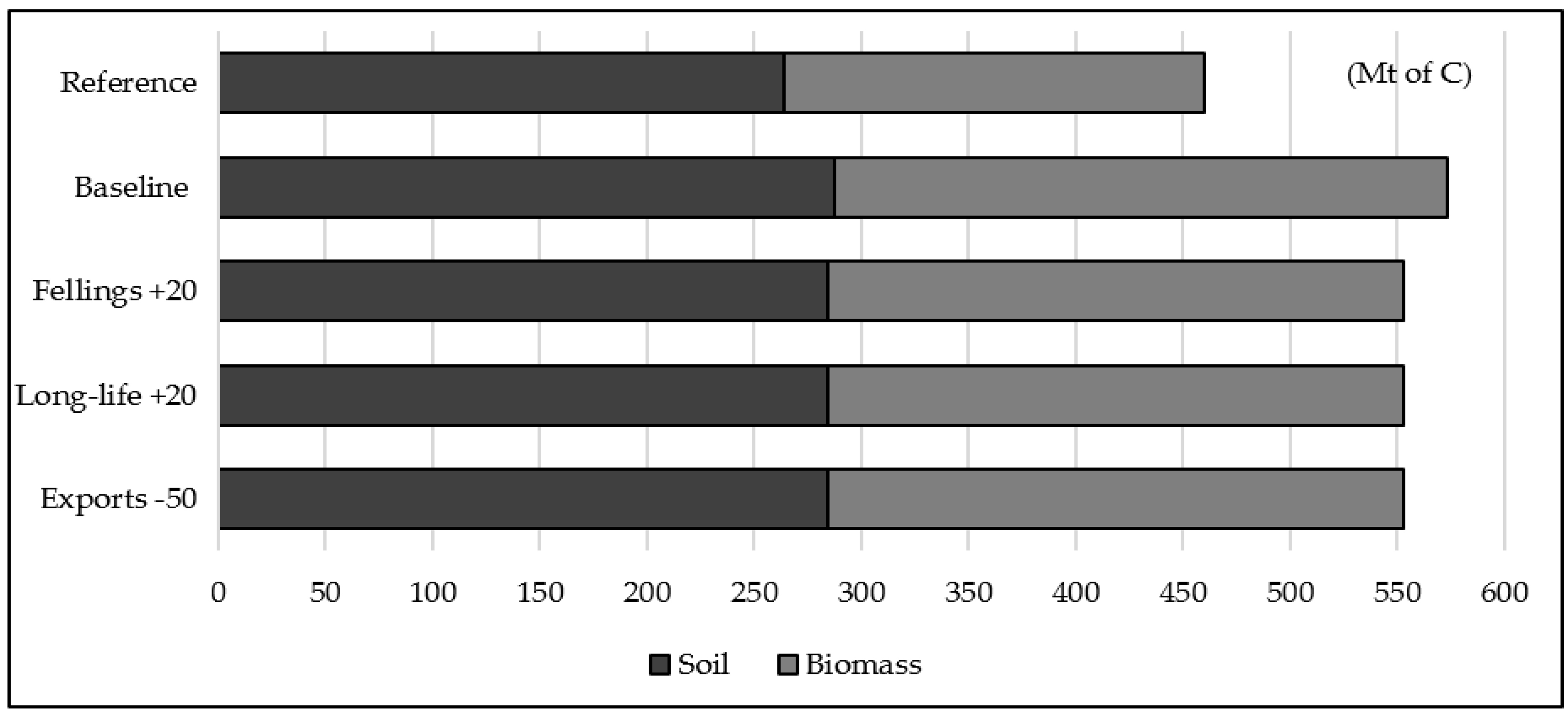
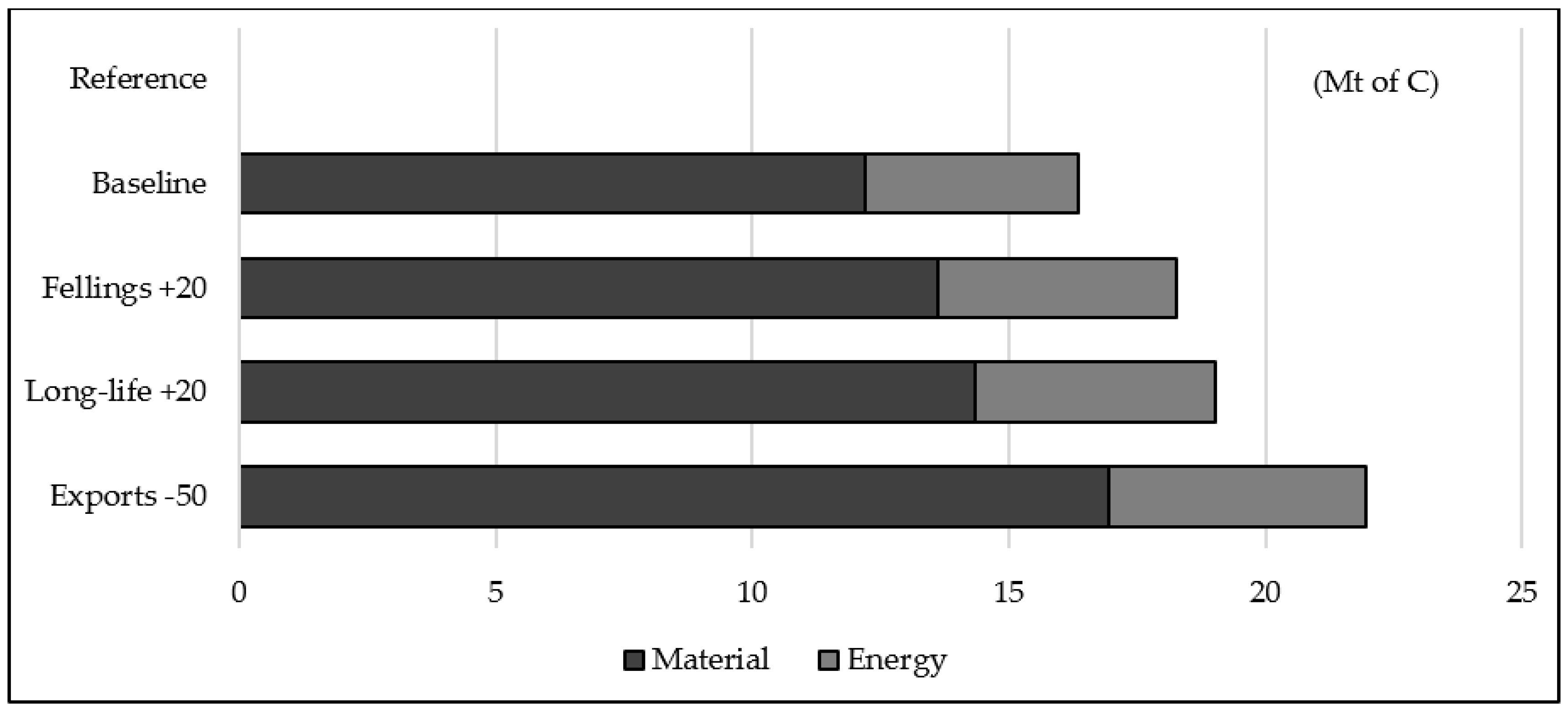
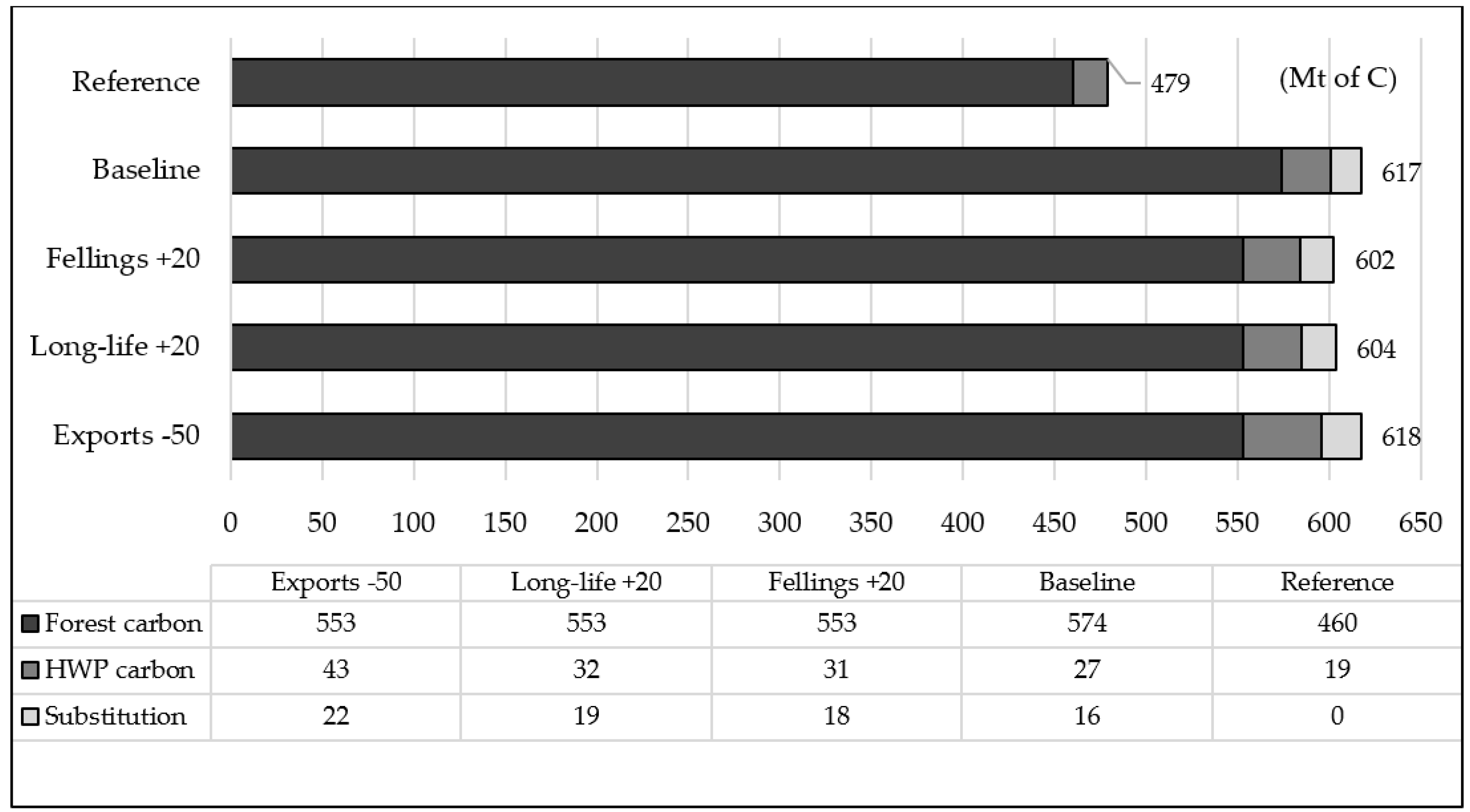
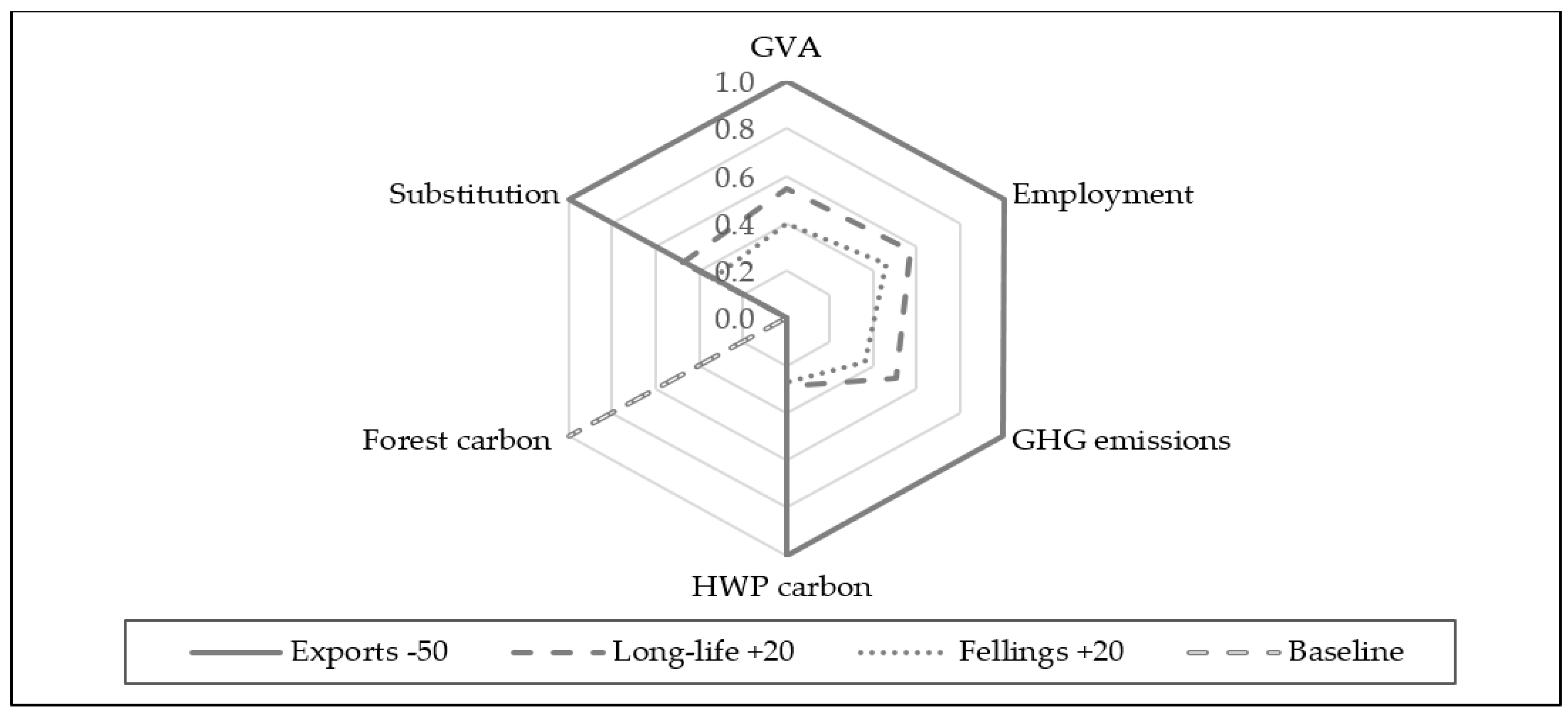
| Indicator | Description |
|---|---|
| Gross value added (GVA) | The gross value added from processes in the value chains in €, at basic prices in 2013. |
| Employment | Number of employees per year from processes in the value chains in full time equivalent. |
| Greenhouse gas (GHG) emissions | Total GHG emissions (Mt of CO2 equivalents) from all processes in the value chains. CO2, CH4, and N2O emissions are converted to the CO2 equivalent by applying global warming potential factors. (CO2 = 1, CH4 = 25, N2O = 298) [33]. |
| HWP carbon stock | Total carbon stock (Mt of C) in the pool of semi-finished HWP. The main factors influencing carbon stock are annual carbon inflow into the pool and half-life values of the products. |
| Forest carbon stock | Total carbon stock (Mt of C) in the forest (living biomass and soil). The main factors influencing forest carbon stock are fellings and age class structure of the forest. |
| Substitution effect | Material and energy substitution effect (Mt of C). When wood replaces more energy-intense materials or fossil fuels, the average displacement factors for material and energy use were applied [34]. |
| Scenario | Description | Model Adjustment | ||
|---|---|---|---|---|
| EFISCEN | Parameter | ToSIA | ||
| Baseline | Fellings will remain at the same level as in the past (average of the five years 2010–2015). However, restitution of private forests will gradually increase fellings by 10% from 2020 to 2035. The shares of semi-finished HWP will remain the same. The share of exports of roundwood will remain at the same level as in the past (average of the five years 2010–2015) | √ | Fellings Flows Shares Export | √ |
| Fellings +20 | This scenario is similar to the “baseline”, but assumes that fellings will gradually increase by an additional 20% from 2020 to 2040 (base year for increase is 2020). | √ | Fellings Flows Shares Export | √ |
| Long-life +20 | This scenario is similar to the “Fellings +20”, but assumes that industrial roundwood resulting from increased fellings will be utilised only for the long-life HWP (sawnwood, wood-based panels, and CLT). Wood use for short-life HWP (EURO pallets) will remain in absolute terms the same as in “Fellings +20”. | √ | Fellings Flows Shares Export | √ √ |
| Exports −50 | This scenario is similar to the “Long-life +20”, but assumes that investments in wood industry will increase production capacity and exports of industrial roundwood will gradually decrease by 50% from 2020 to 2040. | √ | Fellings Flows Shares Export | √ √ √ |
© 2017 by the authors. Licensee MDPI, Basel, Switzerland. This article is an open access article distributed under the terms and conditions of the Creative Commons Attribution (CC BY) license (http://creativecommons.org/licenses/by/4.0/).
Share and Cite
Jasinevičius, G.; Lindner, M.; Verkerk, P.J.; Aleinikovas, M. Assessing Impacts of Wood Utilisation Scenarios for a Lithuanian Bioeconomy: Impacts on Carbon in Forests and Harvested Wood Products and on the Socio-Economic Performance of the Forest-Based Sector. Forests 2017, 8, 133. https://doi.org/10.3390/f8040133
Jasinevičius G, Lindner M, Verkerk PJ, Aleinikovas M. Assessing Impacts of Wood Utilisation Scenarios for a Lithuanian Bioeconomy: Impacts on Carbon in Forests and Harvested Wood Products and on the Socio-Economic Performance of the Forest-Based Sector. Forests. 2017; 8(4):133. https://doi.org/10.3390/f8040133
Chicago/Turabian StyleJasinevičius, Gediminas, Marcus Lindner, Pieter Johannes Verkerk, and Marius Aleinikovas. 2017. "Assessing Impacts of Wood Utilisation Scenarios for a Lithuanian Bioeconomy: Impacts on Carbon in Forests and Harvested Wood Products and on the Socio-Economic Performance of the Forest-Based Sector" Forests 8, no. 4: 133. https://doi.org/10.3390/f8040133
APA StyleJasinevičius, G., Lindner, M., Verkerk, P. J., & Aleinikovas, M. (2017). Assessing Impacts of Wood Utilisation Scenarios for a Lithuanian Bioeconomy: Impacts on Carbon in Forests and Harvested Wood Products and on the Socio-Economic Performance of the Forest-Based Sector. Forests, 8(4), 133. https://doi.org/10.3390/f8040133






